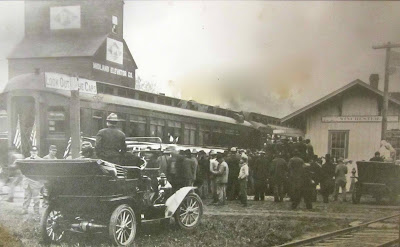By John Wilkins Roberts
From the Oskaloosa
Independent, August 25, 1960
Elizabeth B. Slade brought to the Old Settlers reunion a well-organized account
of her recollections of social events which were held in the courthouse during
the ’seventies and ’eighties before Oskaloosa could boast another gathering place
of equal size. Within two months of her 92nd birthday Mrs. Slade
retains in a remarkable degree her exceptional ability to speak from a public
platform.
At a shady spot in the park Saturday, Aug. 13, she addressed
an audience of fewer than a dozen persons with stories of the courthouse when
it was new.
 |
| Jefferson County courthouse, 1870s. |
Banquets were held in the long corridor of the first floor,
the banqueters being served from adjoining offices. Upper floor was all one big
room, it was provided with a stage and there were held political conventions,
public addresses of many kinds, dramatic performances, costume parties, public
dances. This last-named item had to be discontinued when it was found the
building would be damaged.
Related in detail was Mrs. Slade’s recollection of the dramatized
version of “Ten Nights in a Barroom” in which she played the part of “Little
Angel” when she was about eight years of age. So successful was this
tear-jerking drammer that it had to be repeated to satisfy public demand.
Mrs. Slade was fourth child and elder daughter of William
and Martha Chandler Blevins. He was born in Ireland; at Ft. Leavenworth in 1854
became master of a wagon train whose crew went to build Fort Riley; later was
with troops sent to quell a Mormon uprising; became a trail scout whose
function was to “direct traffic” of the wagon trains across the prairie-Indian
country. At Plum Grove he made his headquarters with J.H.C. Hopewell, a settler
of 1854; met the daughter of a Hickory Point neighbor, Richard Chandler. At the
Osawkee sales of Delaware lands in 1857, Blevins bought the acreage adjoining
the new town of Oskaloosa which was to become the Blevins family home. That
home, often remodeled and beautified, yet stands. A portion of the original
house built on this Blevins estate yet remains in 1960, particularly the small
window frames of the old kitchen. Here William and Martha went to housekeeping
in 1860. Came William N., James, C and John M., then Elizabeth and Sara Esther
(Hannsen).
 |
|
Oskaloosa Grade School, District No., 29, 1922-23, First- and Second Grades
Teacher: Mrs. Elizabeth Blevins Slade
Girls: Violet Thompson, Leona Grant, Martha Brown, Helen
May, Juanita Duffield, Doris Ratliff, Louis Shaw, Agnes Guest, Sylviamae Rice, Pauline
Laster, _____ _____, Marie Stevens, Mrs. Slade with hands on Mabel Brown and Alice
Daniels, Ida English, Leopa Gaines, Emma Lou Todd, Clasteen Holland, Roxie Lee
Nichols
Boys kneeling: John Rice, Robert Barr, Roger Simon, Frankie
Daniels
Boys seated: James Brown, Marvin Icks, Joe Godwin, Blair
Howard, Lewis Metzger, Funston Inverarity, Richard Sutton, William Leech, Philip
Inverarity, Harlan Brown, Jim Cotton, Edward Bell, Ben English
|
Elizabeth tells this of her own schooling: A year or two at
the school on Herkimer street, then at the township school and the Marvin
College preparatory department (on Madison west of Liberty), a year in Julius
Cook’s upper class at the frame schoolhouse (north of Leavenworth and east of
Union), thence to Sisters of Bethany, the Episcopalian college at Topeka, where
she graduated. In California, seeking employment after the tragic death of her
husband by drowning, Elizabeth Slade secured a California certificate, taught
at Santa Maria. Returning to Jefferson County she began that long term of
teaching in Oskaloosa public school which lasted more than 30 years and during
which she started on their academic way scores and scores of children who yet
remember her with deep affection.
But beside Elizabeth’s class room work she had the
imagination, the energy and willingness to work to do many kinds of creative
undertakings. These paragraphs will mention only her relation to Old Settlers reunions.
 |
| The Jefferson County courthouse was destroyed in a tornado, May 19, 1960. |
The Old Settlers reunions began with the first year of the
century, August 1901, and have continued with only two interruptions due to
stringencies of the war years, so that the reunion just completed [in 1960] was
the 58th in series.
 |
| Old Settlers' parade, circa 1900. |
In 1904, the “Old Settlers Central Union” was organized with
an established membership, fees and dues; a leather-bound volume having 360
pages 12 x 18 in size was printed with suitable form for record of visitors.
First entries following “Constitution and By-laws” are names of 156 registrants
at the “4th Annual” old settlers, Aug. 1904. First name in the list
is that of James C. Blevins. Elizabeth was not old enough to “belong” (at the
outset forty years was the minimum) but it is likely she was there, helping
with one of the elaborate parades of those early years which involved nearly
the entire community, both old and young. For many years thereafter, Elizabeth
did creative work, both in the parades and the platform programs, usually by
way of presenting groups of school pupils in some unique manner.
 |
| From the Oskaloosa Independent, May 26, 1960 |
This bound record of old settler visitors has been kept in
the vault of clerk of district court. When that vault was cleared on permanent
records after the tornado [May 1960], Mrs. Myrtle Kimmel “rescued” the old
settler record and it is yet in her possession in her temporary office at the
Ratliff building. Since the 40th reunion, registration has been made
on 5 x 8 cards, which are kept a the Independent
office.
This story appeared in “Yesteryears” in October 1986.
















